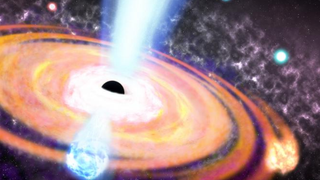Supermassive black holes have bent the laws of physics to grow to monstrous proportions
Scientists have found evidence that black holes that existed less than 1 billion years after the Big Bang may have defied the laws of physics to grow to massive sizes. size. The discovery could solve one of space science’s most pressing mysteries: How did the universe’s first supermassive black holes grow so big, so fast?
Supermassive black holes with masses of millions, or even billions, of the sun are found in the hearts of all major galaxies. They are thought to grow from a series of mergers between accreting black holes, and sometimes by feeding on the material around them. Feeding on supermassive black holes causes the objects around them (in flat clouds called “accretion disks”) to glow so brightly that they can be seen at great distances. Such bright objects are called “quasars” and can outshine the combined light of every star in the constellations in which they live.
However, the processes that allow black holes to reach their “supermassive state” are thought to occur on timescales greater than 1 billion years or so – that means they black hole-powered quasars 500 million years or so after the Big Bang, according to James. The Webb Space Telescope (JWST) has been doing so, posing the biggest (or biggest?) problem for scientists to solve.
To uncover this mystery, a team of researchers used the XMM-Newton and Chandra telescopes to examine the 21 oldest quasars ever discovered in X-ray light. What they found was that these supermassive black holes, which would have appeared in the early universe called the “cosmic dawn” would have rapidly grown into monstrous masses through the explosion of food. strong, or “increasing.”
The findings may finally explain how supermassive black holes formed as quasars in the early universe.
“Our work suggests that the supermassive black holes at the centers of the first quasars that formed in the universe’s billions of years may have accreted their mass very rapidly, they defy the limits of physics,” Alessia Tortosa, who led the research. by scientists at the Italian National Institute of Astrophysics (INAF), said in a statement.
The rapid feeding that these early black holes seem to have undergone is thought to be an anomaly due to a law called the “Eddington limit”.
The answer is to blow the wind
The Eddington limit states that, for any body in accreting matter, there is a maximum luminosity that can be reached before the radiation pressure produced overcomes the gravitational force and forces the material visible from a distance, preventing that information from falling into the accreting body.
In other words, a rapidly consuming black hole must emit so much light from its environment that it slows down its food supply and stops its growth.
The team’s findings suggest that the Eddington limit may be defined, and supermassive black holes may enter a phase of “super-Eddington accretion.” Evidence of this effect came from the relationship between the X-ray radiation emitted by these quasars and the speed of their strong winds, which can reach thousands of kilometers per second. .

That correlation suggested a relationship between the quasar’s wind speed and the temperature of the X-ray-emitting gas closest to the central black hole associated with that quasar. Quasars with low-energy X-rays, and thus cooler gas, appeared to have fast-flowing winds. On the other hand, the high-energy X-rays appeared to have slow-moving winds.
Because the temperature of the gas near the black hole is linked to the processes that allow accretion, this condition suggested a large Eddington component for the supermassive holes that then feed on it. power, therefore, grows rapidly. That could explain how supermassive black holes formed in the early universe before the universe was 1 billion years old.
“The discovery of this connection between X-ray emission and winds is important to understand how such large black holes are formed in such a short time, thus providing a clear clue to solving the ‘ one of the greatest mysteries of modern astronomy,” said Tortosa.
The XMM-Newton data used by the team were collected between 2021 and 2023 as part of the Multi-Year XMM-Newton Heritage Program, led by INAF researcher Luca Zappacosta, and the HYPERION project, which aims to study the -dawn hyperluminous quasars. of the universe.
“For the HYPERION program, we are focusing on two important points: on the one hand, a careful selection of quasars, choosing titans, that is, those that have accumulated the greatest mass,’ and on the other hand, deep. learning about their properties in X-rays, they have never tried so many things at dawn,” Zappacosta said in the statement. “The results we get are truly unexpected, and they all point to a massive Eddington-type mechanism for black holes.
“I’d say we hit the jackpot!”
The team’s research was published Wednesday (Nov. 20) in the journal Astronomy & Astrophysics.
#Supermassive #black #holes #bent #laws #physics #grow #monstrous #proportions